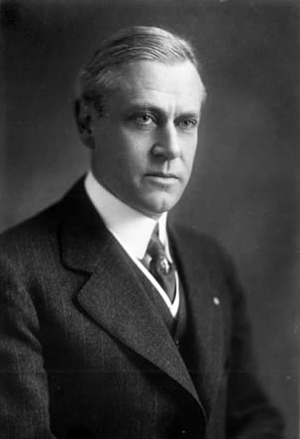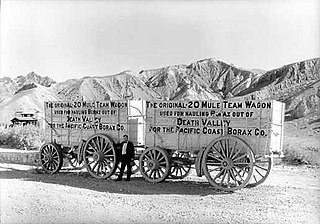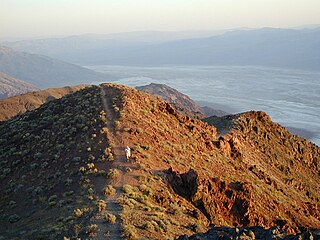Related Research Articles

Stephen Tyng Mather was an American industrialist and conservationist who was the first director of the National Park Service. As president and owner of Thorkildsen-Mather Borax Company he became a millionaire. With his friend the journalist Robert Sterling Yard, Mather led a publicity campaign to promote the creation of a unified federal agency to oversee National Parks administration, which was established in 1916. In 1917, Mather was appointed to lead the NPS, the new agency created within the Department of the Interior. He served until 1929, during which time Mather created a professional civil service organization, increased the numbers of parks and national monuments, and established systematic criteria for adding new properties to the federal system.

Twenty-mule teams were teams of eighteen mules and two horses attached to large wagons that transported borax out of Death Valley from 1883 to 1898. They traveled from mines across the Mojave Desert to the nearest railroad spur, 165 miles (266 km) away in Mojave. The routes were from the Harmony and Amargosa Borax Works to Daggett, California, and later Mojave, California. After Harmony and Amargosa shut down in 1888, the mule team's route was moved to the mines at Borate, 3 miles (5 km) east of Calico, back to Daggett. There they worked from 1891 until 1898 when they were replaced by the Borate and Daggett Railroad.

The Tonopah and Tidewater Railroad was a former class II railroad that served eastern California and southwestern Nevada.

20 Mule Team Borax is a brand of cleaner manufactured in the United States by The Dial Corporation, a subsidiary of Henkel. The product primarily consists of borax, also known as sodium borate, sodium tetraborate, or disodium tetraborate, and is named after the 20-mule teams that were used by William Tell Coleman's company to move borax out of Death Valley, California, to the nearest rail spur between 1883 and 1889.

Francis Marion Smith was an American miner, business magnate and civic builder in the Mojave Desert, the San Francisco Bay Area, and Oakland, California. He was known nationally and internationally as "Borax Smith" and "The Borax King", as his company produced the popular 20-Mule-Team Borax brand of household cleaner.

The Pacific Coast Borax Company (PCB) was a United States mining company founded in 1890 by the American borax magnate Francis Smith, the "Borax King".

The Black Mountains are a mountain range located in the southeastern part of Inyo County, California, within southeastern Death Valley National Park.

The Borate and Daggett Railroad was a 3 ft narrow gauge railroad built to carry borax in the Mojave Desert. The railroad ran about 11 miles (18 km) from Daggett, California, US, to the mining camp of Borate, three miles (4.8 km) to the east of Calico.
Borax is Sodium borate, a boron-containing mineral.

The Oasis at Death Valley, formerly called Furnace Creek Inn and Ranch Resort, is a luxury resort in Furnace Creek, on private land within the boundaries of California's Death Valley National Park. It is owned and operated by Xanterra Travel Collection.

The Harmony Borax Works is located in Death Valley at Furnace Creek Springs, then called Greenland. It is now located within Death Valley National Park in Inyo County, California. It is on the National Register of Historic Places.
Smith Mountain, 5,915 feet (1,803 m), is a peak in the Black Mountains of the Amargosa Range in Death Valley National Park in California.
Lila C is a former settlement in Inyo County, California. It was located 6.25 miles (10 km) southwest of Death Valley Junction, at an elevation of 2562 feet.

Ryan is an unincorporated community in Inyo County, California that is now privately owned and stewarded by the Death Valley Conservancy. A former mining community and company town, Ryan is situated at an elevation of 3,045 feet (928 m) in the Amargosa Range, 8 miles (13 km) northeast of Dante's View and 15 miles (24 km) southeast of Furnace Creek.
Gerstley is a former settlement in Inyo County, California.
Thorkildsen may refer to:
Richard C. Baker was the British business partner of Francis Marion "Borax" Smith and eventually became president of the Pacific Coast Borax Company and the Tonopah and Tidewater Railroad.
Columbus Marsh is a playa in Nevada, United States. William Troup discovered cottonball borax at the site in 1870 or 1871. Joseph Mosheimer and Emile K. Stevenot, who operated one of the borax concentrating plants at Columbus, hired Francis Marion Smith to cut wood for their plant on nearby Miller Mountain in the Candelaria Hills. Smith subsequently discovered borax himself at Teel's Marsh, where he had sufficient financial success to expand and acquire the borax works at Columbus himself in 1880.

The Rio Tinto Boron Mine in Boron, California is California's largest open-pit mine and the largest borax mine in the world, producing nearly half the world's borates. Ore reserves are sufficient for current economic production through early 2040's. It is operated by the Borax division of the Rio Tinto Group.
Thomas Thorkildsen (1869-1950) was an American businessman. He became known as the "Borax King" after his ownership of borax mines in California made him a millionaire.
References
- ↑ "'Borax King' Cleaned Up, but Died Washed Up" Cecilia Rasmussen. Los Angeles Times. March 12, 2000.
- ↑ Hildebrand, GH. (1982) Borax Pioneer: Francis Marion Smith. San Diego: Howell-North Books. pp 88. ISBN 0-8310-7148-6